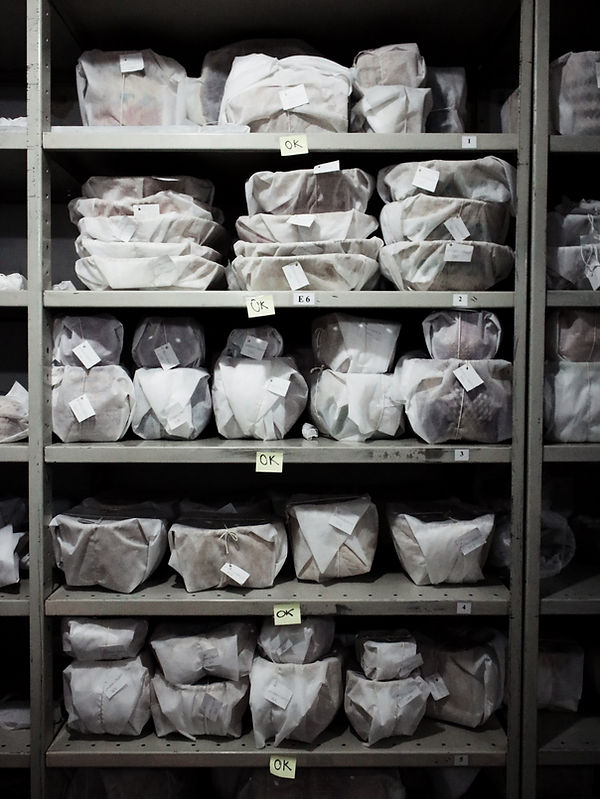Testemunhos da Terra
in partnership with Anelise De Carli
multimedia installation and essay-film
(2024)
PT
A água leva e a água traz. Este projeto nasce de um fenômeno fabulativo: e se, entre os desastres das enchentes de 2024, o Guaíba inesperadamente fizesse aparecer indícios soterrados da sua história?
Cerâmicas são artefatos comumente encontrados em sítios arqueológicos através do trabalho das escavações. Elas são materiais tradicionais dos modos de ser e viver dos povos ameríndios e personagens essenciais para o processo de demarcação de Terras Indígenas. Uma série de processos de datação baseados em alterações químicas ou acúmulo de radiação nas peças permitem a um fragmento de argila queimada contar histórias.
Aqui propomos imaginar aquilo que as áreas inundadas de Porto Alegre poderiam falar. Por consequência da saturação do solo, que ocorre quando um terreno está encharcado por muito tempo, vestígios materiais – tais como peças Mbyá-Guarani – poderiam vir à tona, tornando novamente visível um passado que resistia sob nossos pés. O encontro desses indícios ajudaria a comprovar a presença indígena na região e, assim, áreas inundadas poderiam, de certa forma, falar a favor dos povos em retomada, testemunhando a sua ocupação milenar.
A instalação propõe um diálogo entre o fantasioso e o factual, tensionando as fronteiras entre arte e ciência, campos que acabam delineando aquilo que tomamos como verdade ou mentira, pensável ou impensável. Este universo não é apenasuma homenagem, mas um trabalho de reparação: uma tentativa de recuperar o protagonismo dos modos de ser e viver Guarani e de resguardar suas práticas de cuidado com os seres-terra que conformam o território onde todos vivemos.
Levando em consideração os modos Guarani de ocupação do território, que não deixam rastros monumentais como outras civilizações previam em suas cosmologias, o trabalho e a reflexão sobre eles tentam ouvir o que nunca foi dito, compreender como ouvir a terra, ainda, como ouvir a terra saturada, à procura de história latentes sob o chão e histórias dormentes nas materialidades soterradas e/ou encharcadas. Para evitar que esse silêncio se constitua em silenciamento, apostamos na necessidade de desenvolver formas apuradas de escuta, de maneira a tornar legíveis as ruínas sônicas, inventando dispositivos fabulativos que nos ajudem a ouvir e multiplicando os modos de escuta possíveis, de forma a produzir histórias potenciais (Azoulay, 2019) que façam falar a terra e testemunhar a presença indígena hoje marginalizada e refém dos processos demarcatórios.
O filme-ensaio que acompanha a instalação apresenta três "capítulos" da investigação fabulada. O primeiro, da emergência das escutas e das cerâmicas pelas zonas inundadas de Porto Alegre; o segundo que apresenta a pesquisa realizada no arquivo do museu Joaquim Felizando, acervo que foi inundado e possui diversas cerâmicas guaranís; e o terceiro onde acompanhamos as artistas na sua ida à retomada Mbyá-Guarani na Ponta do Arado, à escuta do que o cacique Timóteo havia contado sobre as cerâmicas muitos anos atrás.
EN
Water carries and water brings. This project stems from a fabled phenomenon: what if, amid the 2024 flood disasters, the Guaíba River unexpectedly revealed buried evidence of its history?
Ceramics are artifacts commonly found in archaeological sites through excavations. They are traditional materials of the Amerindian way of life and are essential to the process of demarcating Indigenous Lands. A series of dating processes based on chemical alterations or the accumulation of radiation in the pieces allows a fragment of fired clay to tell stories.
Here, we propose imagining what the flooded areas of Porto Alegre could say. As a result of soil saturation, which occurs when land is waterlogged for a long time, material remains—such as Mbyá-Guarani pieces—could surface, making visible once again a past that endured beneath our feet. Finding these clues would help prove the Indigenous presence in the region, and thus, flooded areas could, in a way, speak in favor of the reclaiming peoples, bearing witness to their millennia-old occupation.
The installation proposes a dialogue between the fantastical and the factual, blurring the lines between art and science, fields that ultimately define what we consider true or false, thinkable or unthinkable. This universe is not only a tribute, but a work of reparation: an attempt to reclaim the protagonism of the Guarani ways of being and living and to safeguard their practices of caring for the earth-beings that make up the territory where we all live.
Taking into account the Guarani ways of occupying the territory, which do not leave monumental traces as other civilizations anticipated in their cosmologies, the work and reflection on them attempt to hear what has never been said, to understand how to listen to the land, even how to listen to the saturated land, searching for latent histories beneath the ground and dormant stories in buried and/or waterlogged materialities. To prevent this silence from becoming silencing, we believe in the need to develop refined forms of listening, making the sonic ruins legible, inventing fabulatory devices that help us listen and multiplying the possible modes of listening, in order to produce potential stories (Azoulay, 2019) that make the land speak and bear witness to the Indigenous presence, now marginalized and hostage to demarcation processes.
The essay-film accompanying the installation presents three "chapters" of the fabled investigation. The first, on the emergence of listening and ceramics in the flooded areas of Porto Alegre; the second, which presents the research carried out in the archive of the Joaquim Felizando museum, a collection that was flooded and contains several Guaraní ceramics; and the third, where we accompany the artists on their trip to the Mbyá-Guarani reoccupation in Ponta do Arado, listening to what Chief Timóteo had said about the ceramics many years ago.







